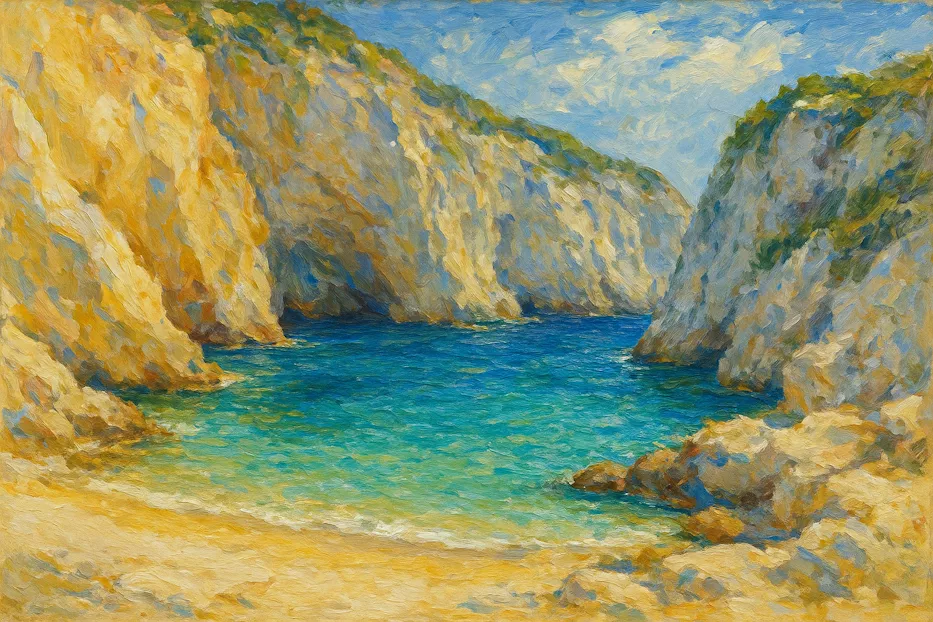Planning a coastal escape to Croatia or Italy? Discover the largest islands in the Adriatic Sea — from Cres and Krk to Vis — where rugged landscapes, turquoise coves, and centuries of history await.
The Adriatic Sea, a sparkling stretch of the Mediterranean nestled between Italy and the Balkan Peninsula, is dotted with more than 1,300 islands. Among these, only a select few command attention through their sheer size, natural beauty, and cultural richness. From the wild landscapes of Cres to the lavender-scented hills of Hvar, these islands offer travelers a diverse mix of history, nature, and adventure.
In this guide, we explore the 10 largest islands in the Adriatic Sea, uncovering what makes each one unique and why they deserve a spot on your travel bucket list. Remarkably, every island on this list belongs to Croatia, a nation whose coastline holds some of the most captivating shores in the Mediterranean.
Table of Contents
10. Vis – Off-the-Beaten-Path Adventure
Area: 90 km²
Region: Dalmatia, Croatia
Highlights: Stiniva Beach, vineyards, secluded coves
Vis is one of the Adriatic’s most remote large islands, historically a military base, which preserved its natural landscapes. Today, it offers an off-the-beaten-path experience with pristine beaches like Stiniva, hidden coves, and local vineyards. Vis is ideal for travelers seeking a combination of adventure, quiet, and authenticity.
Travel Tip: Take a boat tour to the nearby Biševo Island to see the mesmerizing Blue Cave.
9. Rab – Sandy Beaches and Family-Friendly Charm
Area: 93.6 km²
Region: Kvarner, Croatia
Highlights: Sandy beaches, old town, family activities
Rab is unique among Adriatic islands for its sandy beaches, which are a rarity in Croatia. Its old town, with medieval architecture and four bell towers, adds historical appeal. The island’s size and amenities make it suitable for family travel, while still providing enough space for nature walks and cultural exploration.
Travel Tip: Relax at Paradise Beach (Rajska Plaža), considered one of the best family-friendly beaches in Croatia.
8. Mljet – Lush Green Escape
Area: 98 km²
Region: Southern Dalmatia, Croatia
Highlights: Mljet National Park, saltwater lakes, dense forests
Mljet is famed for its tranquility and lush landscapes. The western part of the island is a national park, encompassing two saltwater lakes and dense forests. Ideal for eco-tourism, Mljet offers hiking, cycling, and kayaking opportunities. The island’s relative seclusion preserves a serene atmosphere, making it perfect for travelers looking to reconnect with nature.
Travel Tip: Visit the islet of St. Mary in the middle of Veliko Jezero (Big Lake) for a quiet retreat.
7. Dugi Otok – Nature and Solitude
Area: 114 km²
Region: Northern Dalmatia, Croatia
Highlights: Telašćica Nature Park, Sakarun Beach, cliffs and coves
Dugi Otok, meaning “Long Island,” lives up to its name with a slender, elongated shape stretching across the Adriatic. Its relative remoteness and low development make it a paradise for nature lovers. Telašćica Nature Park offers saltwater lakes, dramatic cliffs, and rich birdlife. The sandy Sakarun Beach, with its turquoise waters, is one of the most photogenic in Croatia.
Travel Tip: Kayak along the cliffs of Telašćica for a unique perspective of the island.
6. Korčula – History, Wine, and Culture
Area: 279 km²
Region: Southern Dalmatia, Croatia
Highlights: Walled town of Korčula, vineyards, cultural heritage
Korčula is often called “Little Dubrovnik” due to its medieval walls and narrow streets. The island is also renowned for its wine production, particularly Grk and Pošip varieties. Korčula balances cultural exploration with natural beauty, making it ideal for travelers who want a large island experience without the party-centric atmosphere of Hvar or Pag.
Travel Tip: Attend the traditional Moreska sword dance in Korčula Town for a glimpse of local history.
5. Pag – Contrast of Wild and Lively
Area: 284.56 km²
Region: Northern Dalmatia, Croatia
Highlights: Zrće Beach, salt pans, Pag cheese
Pag presents a dramatic contrast between stark, rocky landscapes and bustling tourist hubs. Its northern beaches, particularly Zrće, are famous for parties and music festivals, while the southern part of the island retains traditional charm with salt pans and small villages. The island’s unique cheese, Paški sir, is a gastronomic highlight for visitors seeking authentic Croatian flavors.
Travel Tip: Explore the old town of Pag for architecture dating back to the Venetian period.
6. Hvar – Glamour and Lavender
Area: 297 km²
Region: Dalmatia, Croatia
Highlights: Lavender fields, vineyards, historic towns, nightlife
Hvar is often regarded as the Adriatic’s most glamorous island. Its fertile plains are covered with lavender, rosemary, and vineyards, while its historic towns, like Hvar Town, offer architecture dating back centuries. Hvar combines natural beauty with cultural richness, making it a perfect destination for both relaxation and exploration. Its vibrant nightlife attracts visitors from across Europe, yet the island’s size allows for quiet retreats inland.
Travel Tip: Visit the Pakleni Islands just off the coast of Hvar for secluded beaches.
5. Brač – Iconic Beauty and Adventure
Area: 396 km²
Region: Dalmatia, Croatia
Highlights: Zlatni Rat beach, Vidova Gora, water sports
Brač is known worldwide for the Zlatni Rat (Golden Horn) beach, a unique spit of sand that shifts with the currents. Its inland areas boast Vidova Gora, the highest peak in the Adriatic islands at 780 meters, offering sweeping views over the sea. Brač blends adventure, leisure, and culture — from windsurfing and hiking to exploring traditional stone villages. Its proximity to Split makes it a convenient stop for travelers exploring Dalmatia.
Travel Tip: Rent a bike and cycle through the island’s olive groves and vineyards.
2. Krk – Accessible and Versatile
Area: 405.78 km²
Region: Northern Adriatic, Croatia
Highlights: Beaches, historical towns, outdoor activities
Krk, connected to the mainland by the Krčki Bridge, is a versatile destination. Its large size allows for a wide range of activities, from sunbathing on sandy beaches to exploring medieval towns like Krk and Vrbnik. Families, solo travelers, and adventure seekers alike will find something to enjoy here. Krk’s accessibility combined with its natural and cultural offerings makes it one of the most visited large islands in the Adriatic.
Travel Tip: Sample the local Vrbnička Žlahtina wine for a taste of Krk’s heritage.
1. Cres – Nature’s Quiet Giant
Area: 405.78 km²
Region: Kvarner Gulf, Croatia
Highlights: Wild horses, secluded coves, rugged coastline
Cres stands as one of the Adriatic’s largest islands, offering a haven for those seeking tranquility. Due to its steep coastline, Cres is projected to experience slower erosion than Krk as the Adriatic Sea rises, suggesting it will likely remain Croatia’s largest island.
The island’s karst terrain, dotted with pine forests and dramatic cliffs, provides perfect conditions for hiking and wildlife observation. Cres is particularly famous for its herds of wild horses, which roam freely in the interior. Its quiet villages, like the eponymous town of Cres, evoke a sense of timelessness, making the island an ideal escape from crowded tourist spots.
Travel Tip: Hike to the top of Mount Osorščica for panoramic views of the Kvarner Gulf.
Table: The 10 Largest Islands in the Adriatic Sea
| Island | Area (km²) | Region | Highlight |
|---|---|---|---|
| Cres | 405.78 | Kvarner | Wild horses, rugged coast |
| Krk | 405.78 | Northern Adriatic | Beaches, historical towns |
| Brač | 396 | Dalmatia | Zlatni Rat, Vidova Gora |
| Hvar | 297 | Dalmatia | Lavender fields, nightlife |
| Pag | 284.56 | Northern Dalmatia | Zrće Beach, Pag cheese |
| Korčula | 279 | Southern Dalmatia | Medieval town, vineyards |
| Dugi Otok | 114 | Northern Dalmatia | Telašćica Nature Park |
| Mljet | 98 | Southern Dalmatia | Saltwater lakes, forests |
| Rab | 93.6 | Kvarner | Sandy beaches, old town |
| Vis | 90 | Dalmatia | Secluded beaches, vineyards |
Frequently Asked Questions About the Largest Islands in the Adriatic Sea
Q: Which is the largest island in the Adriatic Sea?
A: Cres and Krk are tied as the largest islands in the Adriatic Sea, both covering around 405.78 km². As sea levels in the Adriatic continue to rise, Cres’s dramatic cliffs protect it from erosion more effectively than Krk’s gentler shores. This natural resilience may help Cres stay the largest island in Croatia for centuries to come.
Q: Which Adriatic islands are best for families?
A: Rab and Krk are particularly family-friendly due to sandy beaches, safe swimming areas, and good infrastructure.
Q: Which islands are best for nature lovers?
A: Cres, Dugi Otok, and Mljet are ideal for hiking, wildlife, and quiet exploration.
Q: Are these islands accessible by ferry?
A: Yes, all these islands have ferry or bridge connections from the Croatian mainland.
Q: Which islands have the best nightlife?
A: Hvar and Pag (Zrće Beach) are known for vibrant nightlife, while others are quieter.


